Strapi - Developer Guide
Learn how to install and configure Strapi on AWS with our step-by-step developer guide. This guide covers everything from setting up the environment to optimizing your Strapi deployment for scalability and performance in the cloud.

Welcome to the Meetrix Strapi Developer Guide! Strapi is a flexible headless CMS ideal for building websites, mobile apps, eCommerce platforms, and APIs. It simplifies API creation by automatically generating them from your content models, eliminating the need for backend or database knowledge. This guide offers thorough, step-by-step instructions to help you integrate Strapi smoothly into your development projects.
Video
Blog
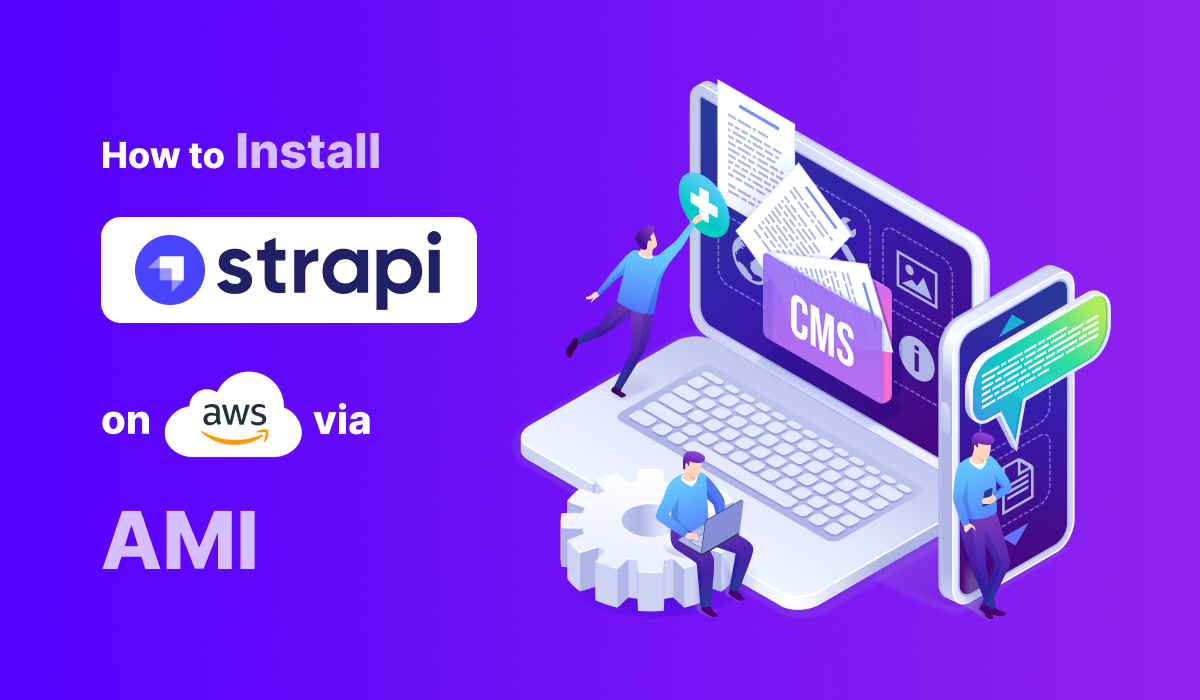
Prerequisites
Before you get started with the Strapi AMI, ensure you have the following prerequisites:
- Basic knowledge of AWS services, including EC2 instances and CloudFormation.
- An active AWS account with appropriate permissions.
- Enough vCPU limit to create instance
(Follow https://meetrix.io/articles/how-to-increase-aws-quota/ blog to ensure this)
Launching the AMI
Step 1: Find and Select 'Strapi' AMI
- Log in to your AWS Management Console.
- Navigate to the 'Strapi' in AWS Marketplace.
Step 2: Initial Setup & Configuration
- Click the "Continue to Subscribe" button.
- After subscribing, you will need to accept the terms and conditions. Click on "Accept Terms" to proceed.
- Please wait for a few minutes while the processing takes place. Once it's completed, click on "Continue to Configuration".
- Select the "CloudFormation script to deploy Strapi" as the fulfilment option and choose your preferred region on the "Configure this software" page. Afterward, click the "Continue to Launch" button.
- From the "Choose Action" dropdown menu in "Launch this software" page, select "Launch CloudFormation" and click "Launch" button.
Create CloudFormation Stack
Step1: Create stack
- Ensure the "Template is ready" radio button is selected under "Prepare template".
2. Click "Next".
Step2: Specify stack options
- Provide a unique "Stack name".
- Provide the "Admin Email" for SSL generation.
- For "DeploymentName", enter a name of your choice.
- Provide a public domain name for "DomainName" (Strapi will automatically try to setup SSL based on provided domain name, if that domain hosted on Route53. Please make sure your domain name hosted on route53. If its unsuccessful then you have to setup SSL manually).
- Choose an instance type, "InstanceType" (Recommended: t3.small).
- Select your preferred "keyName".
- Provide a S3 bucket name to "S3Bucket" for storing Database Backups.
- Set "SSHLocation" as "0.0.0.0/0".
- Keep "SubnetCidrBlock" as "10.0.0.0/24".
- Keep "VpcCidrBlock" as "10.0.0.0/16".
- Click "Next".
Step3: Configure stack options
- Choose "Roll back all stack resources" and "Delete all newly created resources" under the "Stack failure options" section.
- Click "Next".
Step4: Review
- Review and verify the details you've entered.
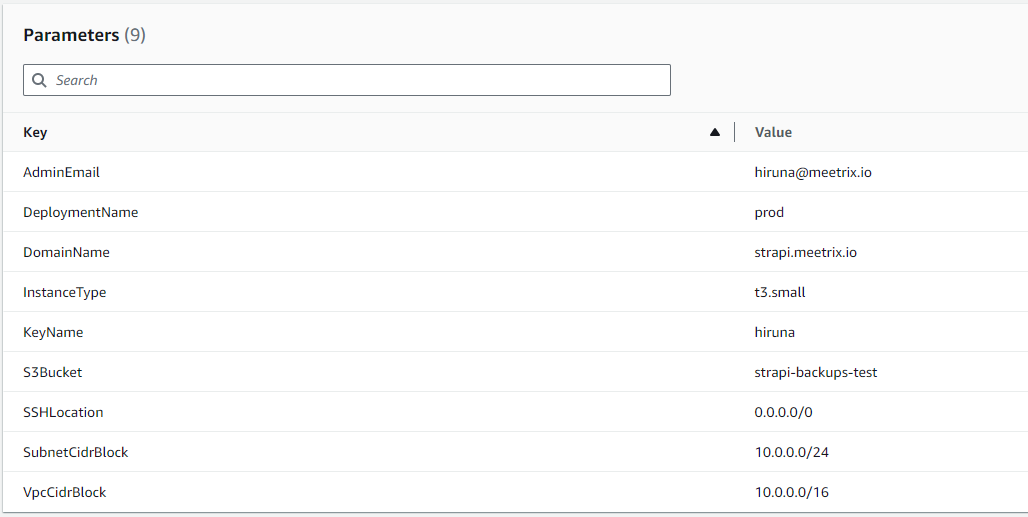
2. Tick the box that says, "I acknowledge that AWS CloudFormation might create IAM resources with custom names".

3. Click "Submit".
Afterward, you'll be directed to the CloudFormation stacks page.
Please wait for 5-10 minutes until the stack has been successfully created.
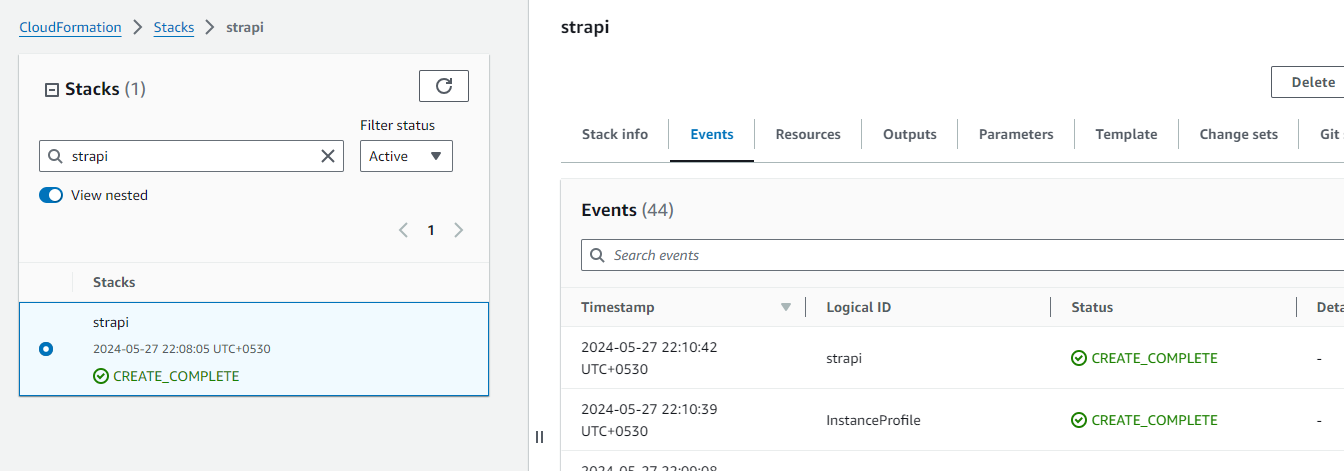
Update DNS
Step1: Copy IP Address
Copy the public Ip labeled "PublicIp" in the "Outputs" tab.

Step2: Update DNS
- Go to AWS Route 53 and navigate to "Hosted Zones".
- From there click on Create record.
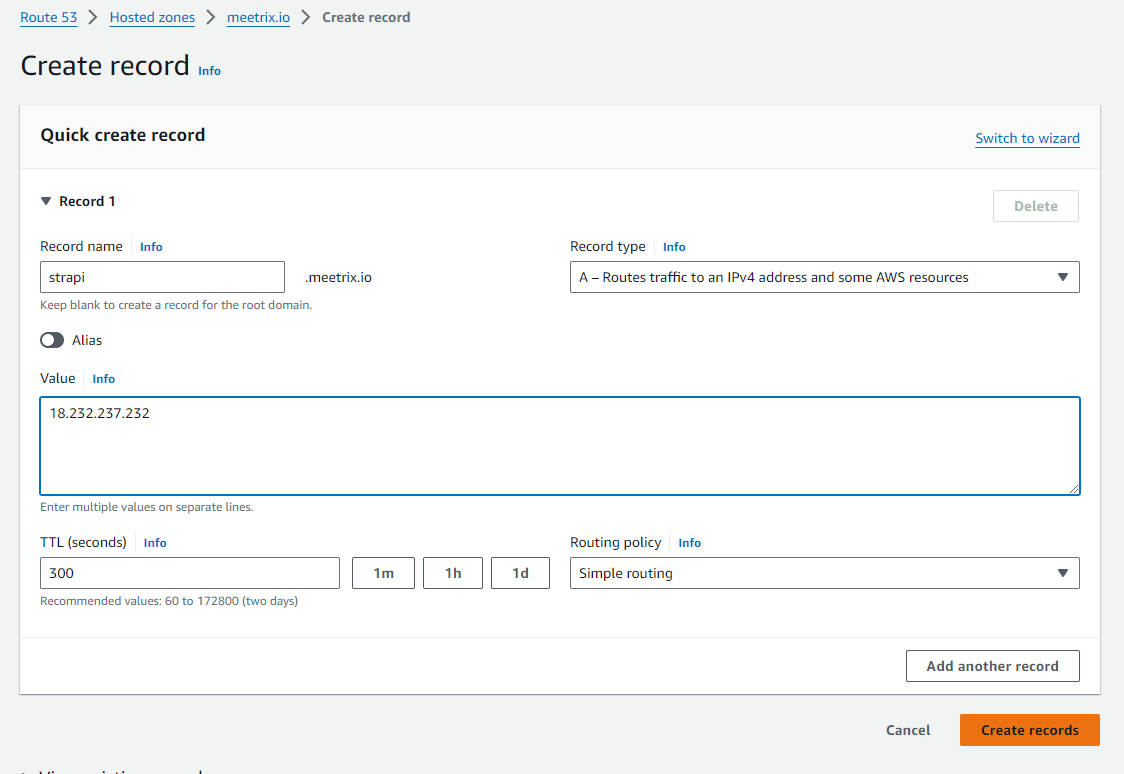
3. Add record name and then paste the copied "PublicIp" into the "value" textbox.
4. Click "Save".
Access Strapi
You can setup the Strapi application through the "DashboardUrl" or "DashboardUrlIp" provided in the "Outputs" tab. This will allow you to create an Admin account and all the future accounts will be created through the Admin panel.

(If you encounter a "502 Bad Gateway error", please wait for about 5 minutes before refreshing the page)
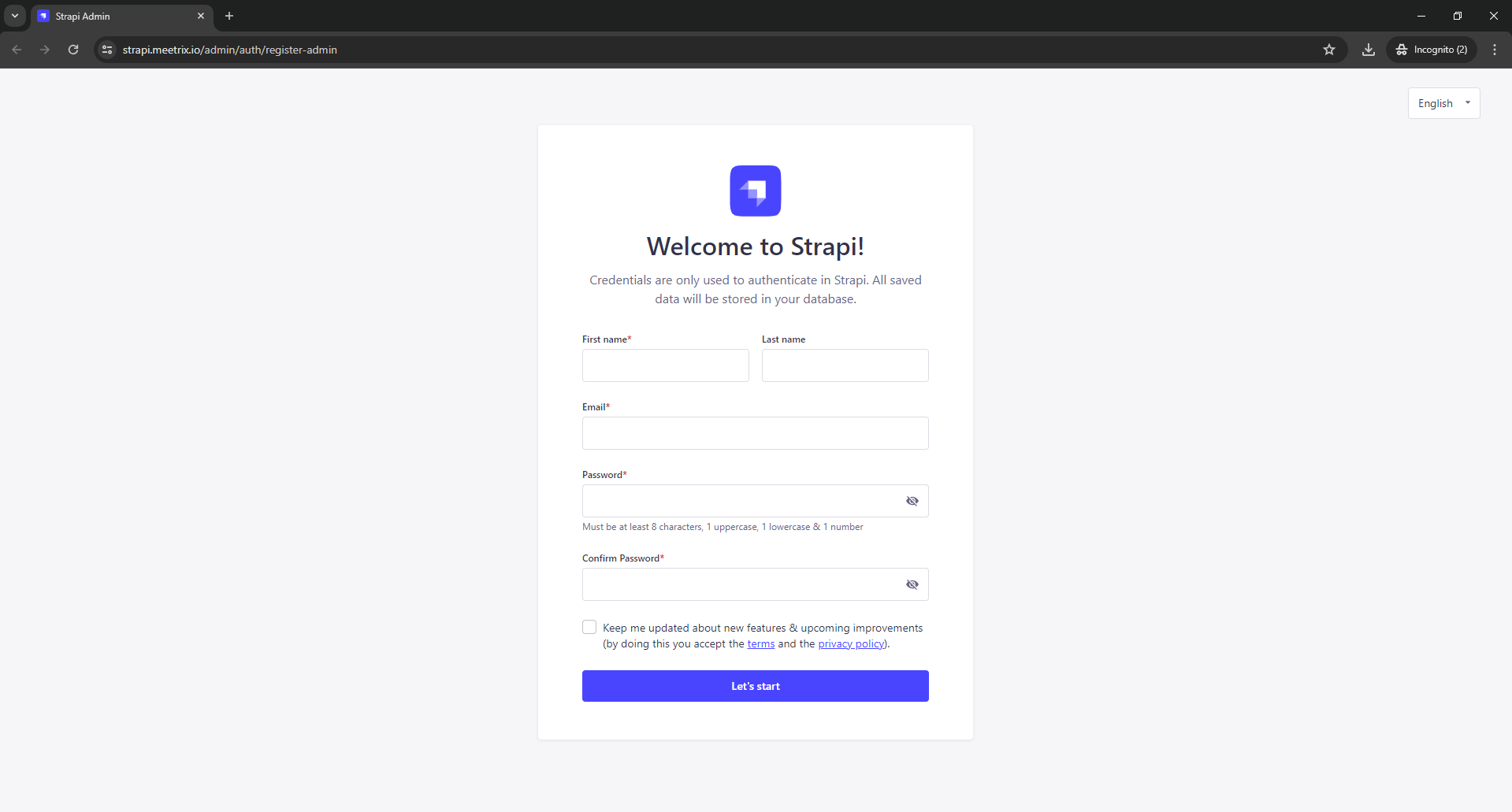
Enter all the details and Click on Let's start button. Make sure to choose a strong password.
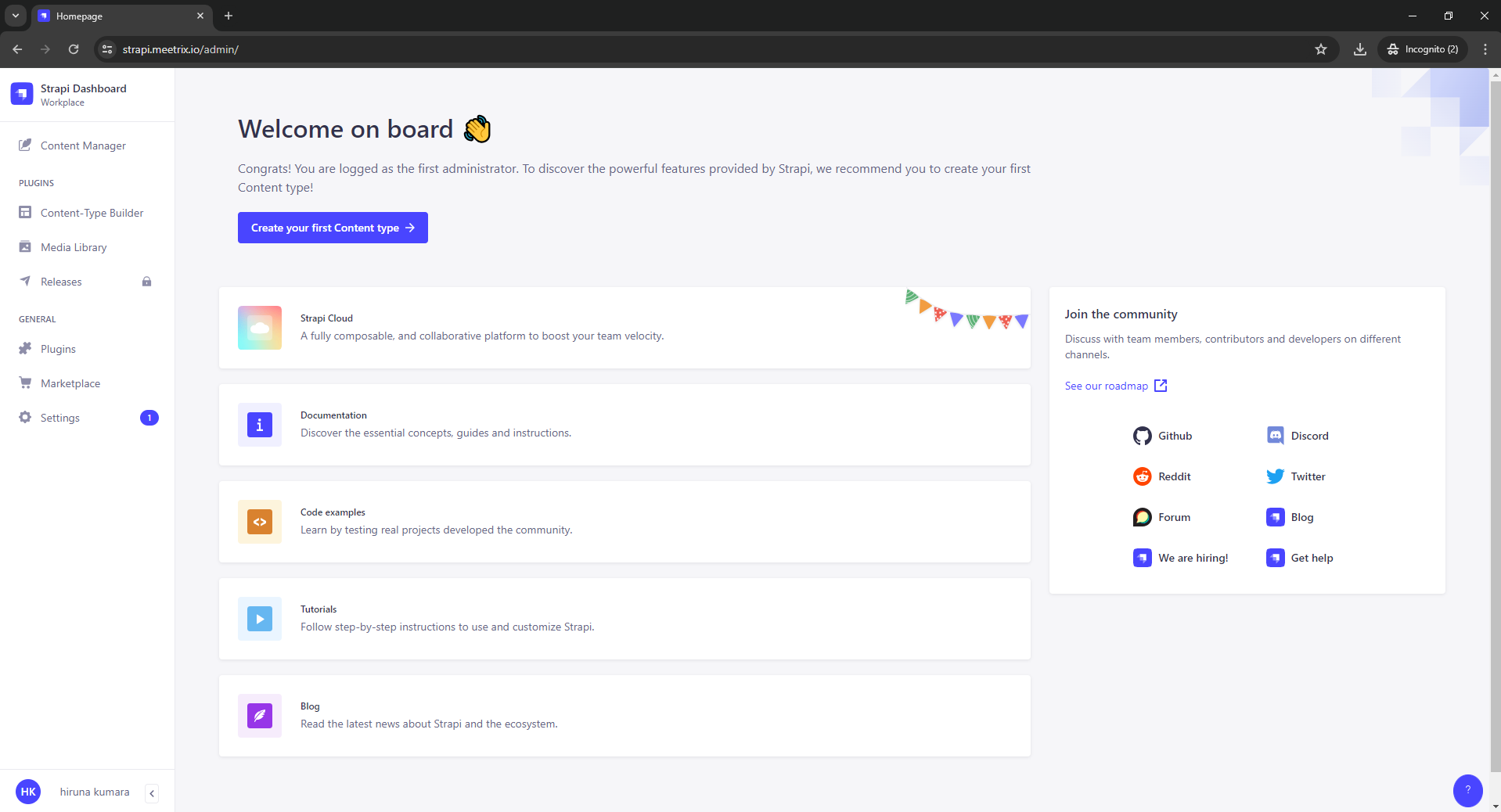
Generate SSL Manually
Strapi will automatically try to setup SSL based on provided domain name, if that domain hosted on Route53. If its unsuccessful then you have to setup SSL manually.
Step1: Copy IP Address
- Proceed with the instructions outlined in the above "Update DNS" section, if you have not already done so.
- Copy the Public IP address indicated as "PublicIp" in the "Outputs" tab.

Step2: Log in to the server
- Open the terminal and go to the directory where your private key is located.
- Paste the following command into your terminal and press Enter:
ssh -i <your key name> ubuntu@<Public IP address>.

3. Type "yes" and press Enter. This will log you into the server.
Step3: Generate SSL
Paste the following command into your terminal and press Enter and follow the instructions:
sudo /root/certificate_generate_standalone.sh
Admin Email is acquiring for generate SSL certificates.
Shutting Down Strapi
- Click the link labeled "Instance" in the "Resources" tab to access the EC2 instance, you will be directed to the Strapi instance in EC2.

2. Select the Strapi instance by marking the checkbox and click "Stop instance" from the "Instance state" dropdown. You can restart the instance at your convenience by selecting "Start instance".

Remove Strapi
Delete the stack that has been created in the AWS Management Console under 'CloudFormation Stacks' by clicking the 'Delete' button.
Conclusion
The Meetrix Strapi Developer Guide is your ultimate resource for flawlessly integrating Strapi into your projects. Whether you're a seasoned developer or just starting out, our guide offers clear, step-by-step instructions to ensure a smooth setup process. Strapi is a powerful and intuitive CMS that simplifies content management and API creation, making it accessible for users of all skill levels. With the Meetrix Strapi Developer Guide, you'll confidently leverage Strapi's capabilities, empowering you to build modern, dynamic web and mobile applications with ease.
Technical Support
Reach out to Meetrix Support (support@meetrix.io) for assistance with Strapi issues.

